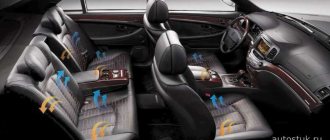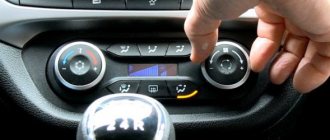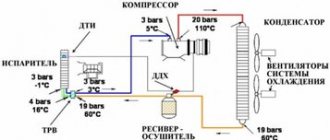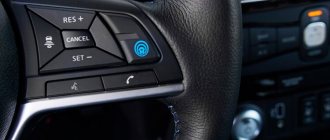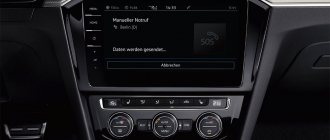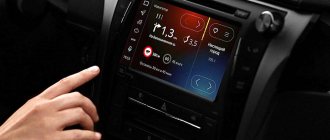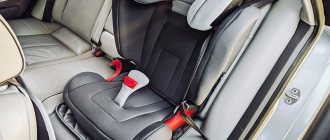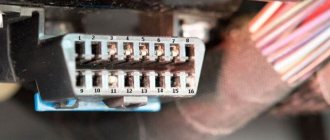Climate control system in the car provides comfort and convenience for the driver and passengers. Its main difference from an air conditioner is that it constantly maintains the specified climatic conditions. The system can be single- or multi-zone. Due to its complexity during operation, car owners may have a number of questions, in particular: “How to use the climate control? What to do, if Climate control does not turn on? How to conduct climate control cleaning? We will try to talk about this and much more in detail.
What is climate control in a car?
Automotive climate control (hereinafter referred to as CC) is a system consisting of an air conditioner, a heater, temperature and humidity sensors, a filtration system and an electronic control unit. The purpose of the system is to maintain the microclimate inside the car, regardless of the weather outside.
The operating principle of climate control is simple. It is based on the operation of an electronic feedback processor, which receives information from numerous sensors that record the temperature in different parts of the car interior. The user sets the desired temperature parameters in the control unit. And the processor supports them all the time, based on information from the sensors, and, if necessary, adjusting the operation of the cooling or heating systems.
The climate control device is fundamentally similar to stationary split-systems with feedback used in various rooms.
Interestingly, the climate control includes not only an air conditioner, but also a heater. Therefore, the system can also be used in winter to heat the interior. In addition, the air conditioner and heater dry the air passing through them. This makes it possible to prevent car windows from fogging up . In more advanced systems, the processor also takes into account the effect of sunlight on the interior temperature (the so-called ultraviolet sensor).
Sometimes there are even more sophisticated options. For example, some Infiniti models have an air ionizer.
Another feature of car climate control is the ability to recirculate air in the car if the outside air is too polluted. This is ensured by monitoring the filtration system. If the degree of air pollution exceeds the permissible norm, then the climate control does not take air from outside, but repeatedly rotates the air volume located in the car’s cabin. As a rule, this happens automatically.
Features of operation in winter
The climate control algorithm described above is quite general. Each manufacturer develops a climate system for a specific model or series. The controller software may also differ slightly. The latest versions of electronic climate control allow the car owner to independently program some of the installation functions. The operation of climate control in a car in winter sometimes requires intervention and switching to manual control:
The car was in an open parking lot and its windows were covered with ice. To start moving, you need to quickly clear the viewing areas from ice. Not all climate control firmwares provide for automatic pre-heating of the windows. There may be a situation where the program provides such a function, but the specified heating time was not enough. In this case, you have to exit the automatic mode and manually turn on the glass defrost. You will also have to choose the fan speed. Once the icing is cleared, you can return to automatic settings.
Climate control unit
- Often, unlucky drivers rely on the warmth inside the car and neglect reliable winter shoes. Inopportunely fallen snow forces us to trample around the car for a while. After freeing the car from a snowdrift, the driver receives wet feet as a bonus. In such a situation, the most correct solution is to switch to manual control and direct the flow of hot air to the legs.
- You can spend quite a lot of time in long winter traffic jams caused by ice and snow. In order to avoid exhaust gases from vehicles accumulated around getting into the car interior, use the “Recirculation” mode. Only very advanced climate control systems are equipped with an automatic CO level analyzer in the external air intake.
Types of climate control and their features
Climate control systems are divided according to different criteria - the presence of separate work zones, power, ease of control, and the presence of additional functions. First, let's talk about single- and multi-zone systems.
Operation of a multi-zone QC system
Today, single-zone, dual-zone, three-zone and four-zone climate controls . What is it and how are they different? Single-zone climate control is the simplest of the systems presented. It is designed according to the principle described above and controls the air parameters in the driver and front passenger area. Dual-zone climate control divides the air space between the driver and front passenger, respectively, into two parts, for which different climate parameters can be set. This provides additional convenience. Three- and four-zone systems also allow you to set individual climate parameters for rear passengers. The last option is considered the most advanced and comfortable.
Now a few words about the differences between climate control systems and the car air conditioning that is familiar today. Let's start with the last one. It performs two functions - it cools the air and dehumidifies it. That is, this device has no feedback. The driver must independently regulate the temperature supplied by the air conditioner in real time. And this is not always convenient. The main difference between climate control is precisely the presence of feedback, which is needed to maintain user-specified parameters on an ongoing basis.
The simplest single-zone climate control can operate in the following modes of automatic supply of cooled or heated air:
- legs;
- head;
- head/legs;
- windshield/legs;
- windshield (in this case, as a rule, the air is additionally dried to prevent fogging).
Multi-zone climate control systems have additional, more advanced operating modes for distributing air in the cabin.
Principle of operation
The structure is able to direct flows to the place where they are needed, so there are no situations where your feet are frozen and you can’t breathe.
This is familiar when many people try to heat the air in a car using an air conditioner. The device takes care to ensure that the driver or passenger does not get hypothermia even when the temperature in the cabin is low and it is quite hot outside. In operating modes, this climate control can regulate and maintain the set mode, send air flows, control humidity so that the windows do not fog up, and filter the air.
The complex is able to control the front glass, legs, glass and legs at the same time, face, legs and face.
Climate control system design
Climate control consists of a large number of devices. In particular:
- Electronic control unit . This is perhaps the most important part of the system, its “brain”. It includes a controller with control programs and an information input system. These can be mechanical or electronic regulators. As a rule, information is entered into modern control units digitally, including using a remote control. Based on the incoming information, the controller program controls the executable devices - the fan rotation speed, the position of the dampers, and issues a command to increase or decrease the temperature of the blown air.
- Sensors _ They are located both inside the car and on the outside. Internal sensors monitor climate indicators in the areas where they are installed. There is also a separate temperature control sensor at the heater/cooler outlet. Interior sensors usually have forced airflow so that they provide information as quickly as possible. The more complex the system (multi-zone), the greater their number. External sensors are designed to monitor the temperature and air pollution outside the vehicle.
- Actuators . There are many devices that fall into this category. In particular, cooling and heating devices (air conditioner and stove), air dampers and their drive motors, air ducts, fans, filters, deflectors, and so on.
Components of the climate control system
It is not at all necessary for the driver to thoroughly know the internal workings of climate control. It is much more important to know the symbols on the climate control control knobs and how to configure the parameters. And also understand what preventive measures to take in order to keep the system in working order.
Main differences
Different cars have completely different cooling and heating systems. What are the differences between air conditioning and climate control?
Air conditioning is a manual control of the temperature of the air pumped into the cabin, as well as the fan speed. This is what most cars have. You manually turn on the air conditioner, select the desired temperature and adjust the fan speed. Depending on the make and model of your vehicle, passengers may have their own controls to achieve this (two-zone operation).
Climate control is a modern, technologically advanced computerized mechanism that independently automates all processes in the car. You can change automatic settings through the on-board computer. Previously, such equipment was found only on expensive cars, but recently middle-class cars have begun to support this function.
Basically, all you have to do is enter the required temperature. The system will then use a series of internal and external sensors to adjust the air supplied to the cabin and the fan speed. There are many such systems on the market, and they all work differently depending on the automaker in question, as well as the make and model.
The main difference between air conditioning and climate control is that the latter allows passengers to set the desired temperature, and the system will automatically maintain it as conditions outside the vehicle change.
Instead of just one setting, the climate control system will allow you to set a specific temperature. Sometimes they will be in half-degree increments, ranging from about 16 to 30 degrees Celsius. Most cars also have a Max setting, which will automatically turn the heater on at full power. This is usually necessary in order to clean the windshield and car windows as quickly as possible with warm air.
Another key difference between air conditioning and climate control is that the latter will most likely have an automatic setting. In addition to the usual controls that direct air to your feet, body or head, and a button that lets you choose between fresh or recirculated cabin air, there's an Auto button that automatically adjusts airflow to maintain the desired temperature difference.
How to use climate control
Different vehicles may use different controls to operate the climate control. But as a rule, the designations on them are standardized. Below we provide up-to-date information.
Review of dual-zone CC control on a Ford Focus 3
How to turn on climate control? Typically, a button with the words ON/OFF or an image of a broken circle is used for this. To turn on the air conditioner, use the button labeled A/C. The temperature in the general or separately in each zone is set using buttons or a rotary controller (roller). As a rule, the adjustment step is 0.5°C. The maximum difference between individual zones is 4...5°C. The AUTO button allows you to directly activate the system so that it automatically maintains the set temperature.
Also, in any climate control unit there are several buttons that indicate the direction of air movement. The minimum number is three. This is blowing the legs, blowing the head and legs, and blowing the windshield. Often there are more modes.
The CC control algorithm is basically the same for everyone; it all comes down to setting the required temperature with a knob or buttons and setting the blowing area. But still, different cars may have their own nuances, so it is better to find how to use climate control in the manual for your car or directly in the climate control operating instructions.
The air conditioning and climate control systems operate most efficiently at high engine speeds. Therefore, after turning them on, it makes sense to switch to a lower gear, while increasing the speed. When the temperature becomes comfortable, you can drive in optimal mode.
It is recommended to check the refrigerant system for leaks at least once a year. If necessary, refrigerant is added to the system. This needs to be done in a special service. It is also advisable to do diagnostics of the electronic unit there.
An example of button designations on the climate control control panel in Volkswagen cars
One more tip. The climate control system (like the air conditioner) must be turned on no earlier than one minute after starting the engine . And at the end of the trip it’s the other way around. Turn off the air conditioner at least one minute before stopping the engine.
The difference between the air temperature outside the car and inside the car should not exceed 10°C. Otherwise there is a risk to your health.
What are the features of climate control?
If the climate control needs heat, it gets it from the heater core. That is why in the cold season the system begins to drive hot air only after the engine and antifreeze have warmed up. However, some cars have autonomous heaters that significantly speed up this process, and warm air comes out of the deflectors almost immediately after starting the engine. For this system to work effectively in a car with an internal combustion engine, the latter must be running. Electric vehicles use a separate heater, which significantly drains the battery.
As for the cooling that the air conditioner is responsible for, for it to work properly, the system must have the required level of freon. If this is not the case, refueling is necessary. It is customary to check the climate control unit before periods of intensive use. It is especially needed in summer and winter, so it is diagnosed in spring and autumn. Typically, maintenance simply means refilling the air conditioner with freon. However, from time to time it may also be necessary to repair fans and other system elements. You should also not forget about replacing the air filter.
An unscheduled check of the climate control system is necessary if the unit is not working correctly | BMW Club
Installation of climate control
Some car owners whose cars are not equipped with a climate control system decide to install it additionally. This task requires spending a lot of time, money and effort. In addition, you need to know that the QC system may not be installed on every machine. After all, the fact is that the stove must be of a certain design so that it is possible to install various servos and wiring under the “dashboard”.
But if you still decide to install an additional climate control system on your own or with the help of specialists, then you will need the following list of devices and assemblies (may differ for different cars):
- electrical wiring from a similar car that has a climate control system (this is a whole wiring harness);
- a stove that was installed on a similar machine with a CC system, and working servos must be attached to it;
- two temperature sensors installed in the stove pipe;
- two temperature sensors installed in the central air ducts;
- solar radiation sensor (may not be part of the CC system);
- fan sensor with a cover-mount (the cover is usually very difficult to find); frame;
- control unit (the only element that is widely available).
Often, when installing a system, it is necessary to change the factory “torpedo” of the car. For this, different methods and materials are used. For example, fiberglass, from which additional elements are made for attaching CC controls. Work must be performed carefully so as not to damage factory elements.
The stove doesn't heat well
Car owners begin to notice that the stove is not heating well only with the arrival of cold weather, although the reasons for poor performance arise much earlier. Most often, the stove in a car heats poorly due to: airing, a faulty pump, a clogged radiator and cabin filter Read more
Car heater and care
A car heater is a heater radiator with the entire system as a whole. Periodic maintenance is required for proper functioning. The list of required work includes: checking, cleaning and replacing the cabin filter Read more
Diagnostics, repair and refilling of car air conditioning
A visual guide to car air conditioning maintenance and repair will help you properly maintain your car's air conditioner. Diagnostics are carried out not only when refilling freon, but also every seasonal maintenance.
Climate control, the difference between climate control and conventional air conditioning
by admin May 19, 2014
With the advent of such a system as climate control, many motorists have forgotten about the old days when they had to constantly adjust something in order for the air conditioner to work as desired. Climate control includes air conditioning, heating system, as well as a filtration system.
Special sensors located in different places of the car allow you to automatically regulate the temperature and maintain maximum comfort in the cabin.
For example, the electronic unit even takes into account the street temperature and solar radiation, plus it is definitely worth noting that the intelligent system does everything possible to prevent the driver and passengers from catching a cold.
The difference between climate control and conventional air conditioning
Some novice motorists often confuse two concepts: a climate control system (climate control) and a regular air conditioner. That is, they do not see any fundamental differences between them. In fact, an intelligent climate control system is strikingly different from an air conditioner primarily in its advantages:
- Carries out adjustment and further support of the set temperature.
- It is safer because it directs the air flow only where it is really needed.
- In addition to temperature, it also regulates humidity. In other words, climate control eliminates stuffiness and fogging of windows.
- Availability of various additional functions. For example, many modern models take into account, among other things, the state of the environment. If the level of pollution is exceeded, the system goes into a special recirculation mode - the polluted air leaves the cabin.
Climate control is a much more complex system than a conventional air conditioner, which has only one advantage - the ability to very quickly cool the car interior. Although even this advantage can be disputed, because in this case the driver and passengers can easily catch a cold.
Intelligent system management
At first glance, it may seem that climate control is a rather complex system, the management of which requires some special skills. But in reality everything is much simpler, and it is not even necessary to read the instructions for use. Climate control can be carried out in two modes: manual and automatic. In the first case, you need to be an experienced user in order to be aware of all the subtleties in the operation of the system, because any incorrect press significantly affects the service life of the system.
- Manual mode. You can control fan speed, air flow, heating and cooling levels manually. Typically, this mode is turned on if the car interior is very hot or cold, and manual adjustment allows you to quickly deal with this problem.
- Auto mode. The driver just needs to turn it on and set the desired temperature, the climate control system will do the rest itself. Unfortunately, a certain part of motorists do not use the automatic mode due to the high noise level (for the first time after switching on, the fans work, as they say, to their fullest). But! As soon as the temperature in the cabin reaches the desired level, the system itself switches to silent mode. That is, it only maintains the temperature and redirects the air to the right places.
What to do when climate control does not work
Self-diagnosis of climate control on Nissan Tiida
The QC system, like any mechanism, can fail. Let's take a closer look at how to independently diagnose climate control . Let’s immediately make a reservation that different machines and systems may have their own specifics, and even more so the decoding of their errors. As an example, let's look at the QC self-diagnosis on a Nissan Tiida. The verification algorithm looks like this:
- Turn on the ignition and press the OFF button in order to set the CC system to self-diagnosis mode. At the same time, all the elements present there will appear on the screen, and the corresponding indicators will light up next to the buttons. The first diagnostic step is to check whether all of the listed elements are lit.
- The second diagnostic stage is to check for open circuits in the temperature sensors. To do this, use a roller to increase the temperature one step. The display shows the number “2”. At the same time, self-diagnosis of the circuits is performed to determine the presence of breaks in them. If after some time “20” is displayed instead of “2”, this means that no faults were detected. If instead there is another number, then this will be an error code, the decoding of which you can see in the manual.
- Checking the position of the damper mixers and the blower damper. You need to raise the temperature one more step. The number “3” will appear on the screen. After which a self-diagnosis will occur. If there are no faults, then the number “3” will turn into “30”. Otherwise, you should also look for an explanation of the error in additional literature.
- Check the motors of all dampers in the system. To do this, raise the temperature again by one degree. There are 6 different dampers on the machine. Switching between them is done by pressing the corresponding buttons with images of the blowing direction. At the same time, each of them turns on in turn, and the driver can tactilely check whether air is coming from the air ducts or not.
- Temperature check detected by sensors. The procedure is carried out on a cold machine to avoid large variations in readings. To do this, we again increase the temperature by one step. The number “5” lights up on the display. The first thing to check is the ambient temperature sensor. Press the windshield defogger button. You will see the outside temperature on the screen. The next time you press the button, you will see information from the cabin temperature sensor (in degrees Celsius). When you press the same button a third time, information about the intake air temperature (also in degrees Celsius) will appear on the display.
- Correction of temperature sensor readings. With its help, you can set the adjustment range for the temperature detected by the sensor in the range from -3°C to +3°C. To do this, you need to set the diagnostic mode to “5” again, and then use the fan speed control knob to increase them by one position. In this case, the display shows “0”, which corresponds to the fact that the sensor will show the temperature without adjustment. By rotating the knob to the right or left, you can set any value from -3°C to +3°C. This makes it possible to correct the actual temperature value compared to the one produced by the sensor.
Let us repeat that climate control diagnostics differ on different machines. You can find the exact algorithm and explanation of errors (if any) only in the manual of your car or the CC itself.
What is dual-zone or three-zone climate control?
Many expensive cars today are equipped with such an outlandish option as multi-zone climate control. This means that the driver can adjust certain parameters for himself, and the passenger in the front seat can easily make other settings and create his own microclimate. Of course, the temperature difference in two zones often cannot exceed 2-4 degrees, but you must agree that this is a very interesting technical innovation. There are cars with three-zone climate control, when the driver, front passenger and the entire row of rear passengers can independently control the climate. There are also cars with four climate control zones. This option is important in the following cases:
- The family is going on a trip and needs to adjust the climate for the rear sofa where the children sit;
- premium cars for transporting high-ranking politicians and businessmen require a separate microclimate for each passenger;
- long cars with three rows of seats or several spaces separated by a partition should be equipped with a multi-zone climate;
- SUVs with a lot of space often do not create a uniform climate well, so it is better to use several separate zones;
- When there is nothing else to add to the car's package, multi-zone climate control is usually added.
Today, this option is necessary only in some situations, but almost all top-end configurations of expensive cars do not install the expensive unit. This makes the car more expensive, but often distinguishes it from competitors with an advantageous addition, a technological innovation. If previously any kind of climate control was a curiosity, today the exotic thing is to create a separate microclimate for each passenger. And as long as people are willing to pay a lot of money for this, the option will remain in the premium equipment class. Experts believe that in a few years, almost all cars in any configuration will be equipped with just such an internal climate control device. However, there is no reason not to believe in such statements, because a conventional manual air conditioner has long since left the category of exotic additions to a car’s configuration.
Malfunction prevention
In order for the climate control system in a car to work properly, it is necessary to periodically service its individual components. First of all, we are talking about the air conditioner radiator. Freon pressure should always be normal and should be monitored at least once a year.
Don't forget to periodically change the cabin ventilation filter . Especially if you frequently use the climate control system. Over time, it becomes clogged and the performance of the ventilation system decreases. And, of course, you have to breathe in the accumulated dust and germs. It is also necessary to clean the air conditioner radiator from dust accumulated on its surface. To do this, the system must be turned on periodically for ventilation, even in winter, at least once a month, for at least 5...10 minutes.
The third preventative measure is to clean the interior ventilation . There are several methods for this. For this purpose, special means are used - cleaners, aerosols, steam generators, “smoke bombs”. They effectively cleanse the system and destroy harmful microorganisms in it.
Advantages and disadvantages of climate control
Like any technical system, climate control has its advantages and disadvantages. They are identified not only by specialists, but also by ordinary consumers. Let's start by listing the advantages:
- ensuring comfortable living conditions in the car for the driver and passengers (especially for multi-zone systems);
- automatic operating mode;
- a large number of adjustable parameters;
- minimizing human participation in the operation of the system;
- a simple, convenient and intuitive interface that ensures quick learning of working with the system.
Disadvantages of climate control include:
- increased price of a car equipped with such a system;
- high cost of maintenance and repair;
- increased fuel consumption when the system is used;
- Repairing the climate control system yourself is not possible.
However, despite the existing shortcomings, more and more modern cars are equipped with a climate control system as standard. Engineers find new solutions for its implementation, and mass production makes it possible to constantly reduce the price.
Conclusion
The climate control system allows the driver and passengers of the car to create a comfortable atmosphere in the cabin for long trips. Unlike a traditional air conditioner, it has feedback , allowing the output temperature to be adjusted in real time based on changing input data. And this, firstly, creates comfort for people, and secondly, minimizes their participation in managing the system. However, during operation, do not forget to clean and maintain the climate control. This will ensure its long and trouble-free operation. It is advisable to use climate control not only during long trips, but also when driving in city traffic jams.
Some modern cars that have an engine preheating function, as a rule, make it possible to turn on the climate control before the driver enters the cabin in order to create a comfortable temperature in advance.
If you decide to buy a new car, be sure to look for a model with climate control. You certainly won't regret it!
Operating principle of single-zone and dual-zone climate controls
› Air system ›
16.09.2017
The advantage of climate control over a conventional stove, even with air conditioning, is undeniable. For a comfortable stay in the car, you just need to set the temperature that is acceptable for you once, and the system will quickly dial it up and maintain it throughout the entire trip.
All control is carried out by an electronic unit that receives information from sensors installed inside the cabin and on the street side and gives a command to turn on the heater (or air conditioner, depending on the weather outside). Next, the electronics regulate the flow temperature and its intensity to maintain the set values.
Special elements check the air for the presence of harmful impurities, unpleasant odors and high humidity; if detected, they filter and dry the air entering the cabin, which has a positive effect on the well-being of passengers and the performance of the driver.
If you use the system in automatic mode, the windows in the car will not fog up, this will make the trip safer and more comfortable. But the comfortable temperature conditions for the passenger and the driver may not be the same. To do this, cars are equipped with systems that allow you to set separate temperatures for the driver and his fellow travelers. There are one-, two-, three-, and even four-zone climate controls. The more zones the interior has, the more expensive the cost of the entire vehicle will be, since more sensors and control modules must be used for its operation.
Single-zone climate control
This is heating and air conditioning contained in one unit and controlled by one module. Allows both manual and automatic configuration. When setting the automatic mode, the air flow is blown out of the deflectors and has a temperature that allows you to maintain the set values. When input parameters change, the control unit makes corresponding changes that affect the flow temperature so that the conditions in the cabin remain unchanged.
An air recirculation mode is available, which allows you to take air not from the street, but from the car interior, which allows you to cool the interior much faster. When the automatic mode is turned on, the readings in the front part of the cabin and in the rear will be different, which will certainly cause disagreements between the driver and rear row passengers, since for each person the concept of “comfortable temperature” is individual, it is difficult to choose parameters that will be ideal for everyone who is in car interior.
Therefore, it will not be possible to completely isolate the driver from participating in the regulation, which will negatively affect road safety.
Dual zone climate control
These are not two separate units, but two sets of controls for one system, which allows the front passenger to set their own microclimate. This option will undoubtedly affect the cost of the car, but it will significantly increase the comfort inside the car. Now the passenger can set parameters that are comfortable for themselves, while the parameters on the driver’s side will remain unchanged. This occurs due to the separation of system control devices and separate sensors for each side.
Some vehicles are equipped with three- or even four-zone climate controls. These additional controls are intended for the rear row. To do this, the back row is equipped with its own air ducts and its own sensors, which allows everyone to set a comfortable temperature for themselves. However, the most common is 2-zone climate control.
It is usually equipped with two regulators, one on each side of the control unit, so that both the driver and passenger have the opportunity to create their own microclimates.
Some control units are equipped with their own fan speed controllers with the ability to change the direction of the air flow. And others are limited to installing the flow temperature control knob.
Naturally, the price of dual-zone climate control is significantly higher than its predecessor, but it will be a big plus for comfort if you are traveling with a passenger. Also, to be fair, it is worth noting that there are no physical partitions in the car separating different areas.
The difference between the zones is 3 – 4° C, depending on the car. But for most people, these parameters will be enough to feel comfortable.
Most new cars equipped with climate control will have at least two zones. When choosing a vehicle, you should consider how many people will most often travel in the car. If passengers in the car are not often, then there is no point in overpaying for additional equipment. For a family car, this option will be necessary.
Operating principle of single-zone and dual-zone climate controls Link to main publication
Source: https://remam.ru/vozdsys/chto-takoe-odnozonnyj-dvuhzonnyj-klimat-kontrol.html
